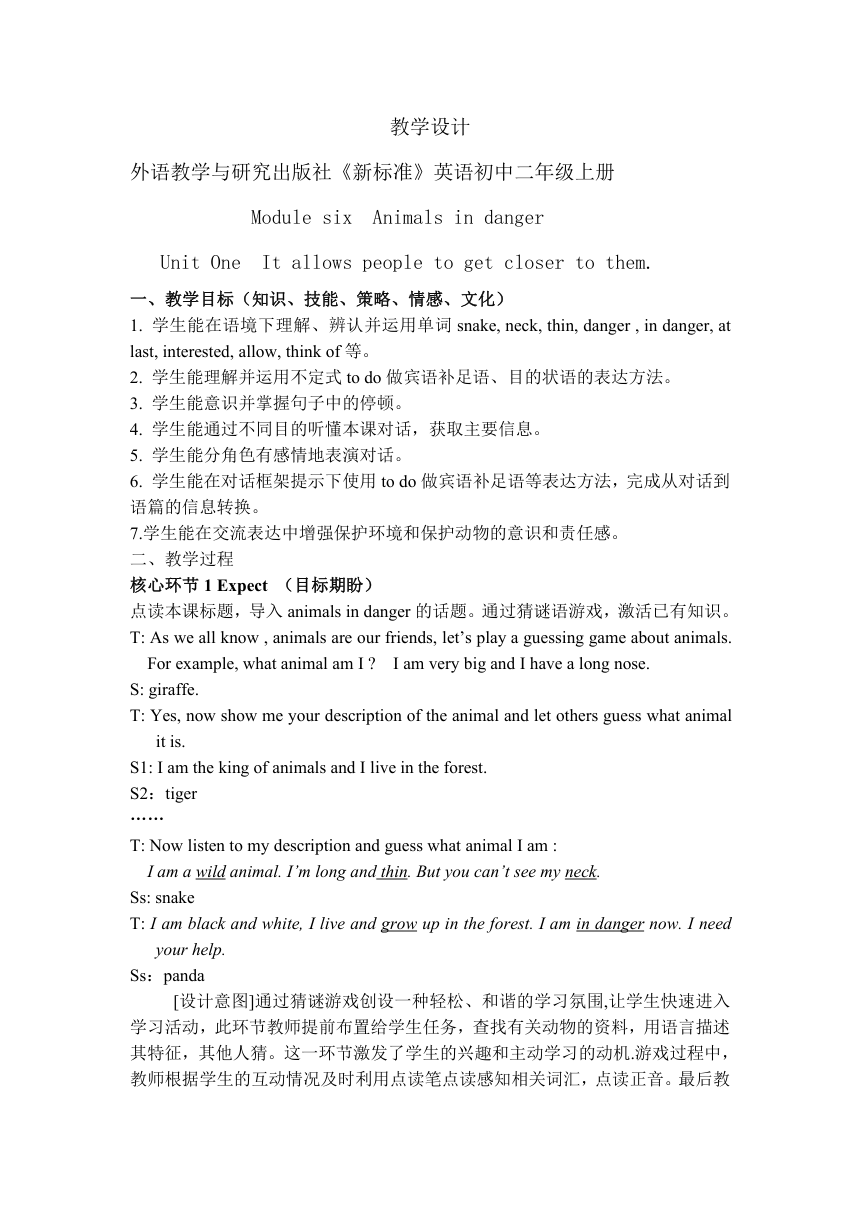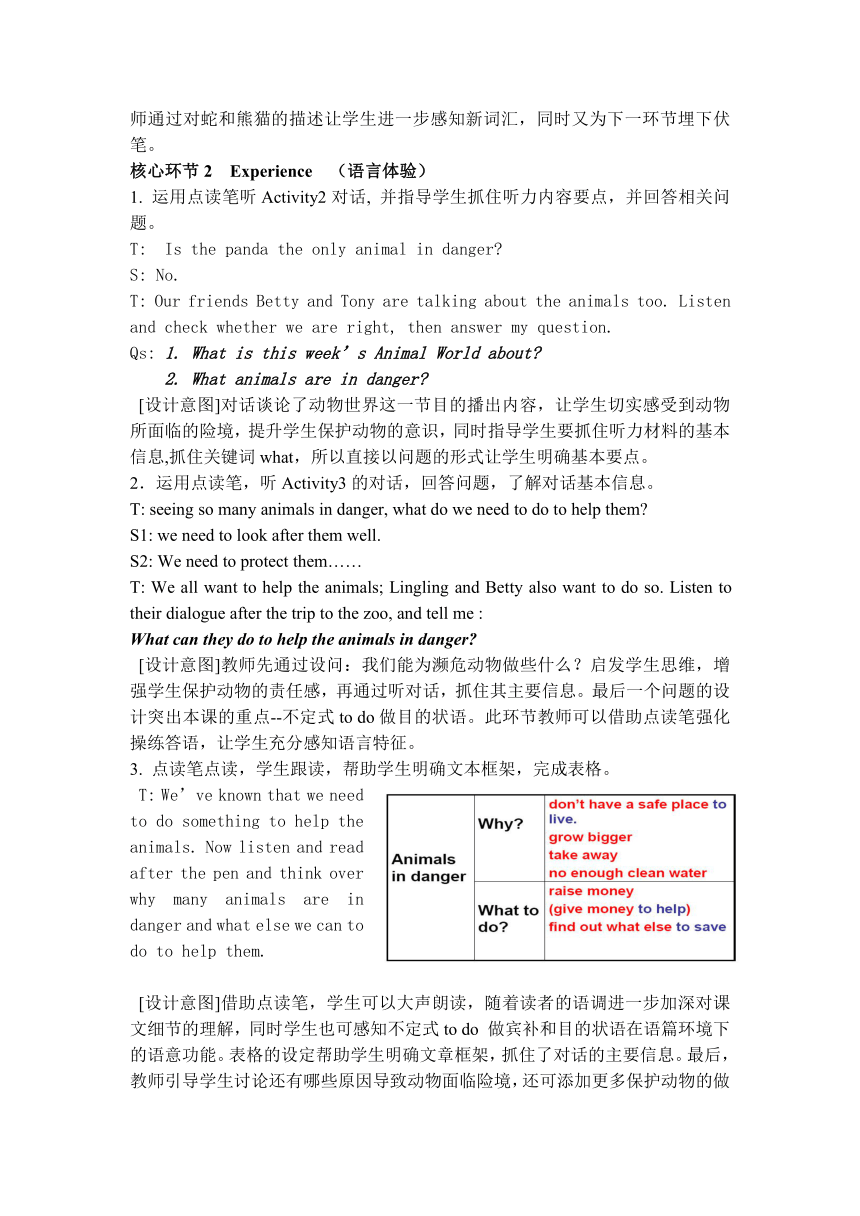外研版八年级英语上册教案:Module6Unit 1 It allows people to get closer to them
文档属性
| 名称 | 外研版八年级英语上册教案:Module6Unit 1 It allows people to get closer to them |  | |
| 格式 | zip | ||
| 文件大小 | 302.0KB | ||
| 资源类型 | 教案 | ||
| 版本资源 | 外研版 | ||
| 科目 | 英语 | ||
| 更新时间 | 2017-07-15 21:16:50 | ||
图片预览


文档简介
教学设计
外语教学与研究出版社《新标准》英语初中二年级上册
Module
six
Animals
in
danger
Unit
One
It
allows
people
to
get
closer
to
them.
一、教学目标(知识、技能、策略、情感、文化)
1.
学生能在语境下理解、辨认并运用单词snake,
neck,
thin,
danger
,
in
danger,
at
last,
interested,
allow,
think
of等。
2.
学生能理解并运用不定式to
do做宾语补足语、目的状语的表达方法。
3.
学生能意识并掌握句子中的停顿。
4.
学生能通过不同目的听懂本课对话,获取主要信息。
5.
学生能分角色有感情地表演对话。
6.
学生能在对话框架提示下使用to
do做宾语补足语等表达方法,完成从对话到语篇的信息转换。
7.学生能在交流表达中增强保护环境和保护动物的意识和责任感。
二、教学过程
核心环节1
Expect
(目标期盼)
点读本课标题,导入animals
in
danger的话题。通过猜谜语游戏,激活已有知识。
T:
As
we
all
know
,
animals
are
our
friends,
let’s
play
a
guessing
game
about
animals.
For
example,
what
animal
am
I
I
am
very
big
and
I
have
a
long
nose.
S:
giraffe.
T:
Yes,
now
show
me
your
description
of
the
animal
and
let
others
guess
what
animal
it
is.
S1:
I
am
the
king
of
animals
and
I
live
in
the
forest.
S2:tiger
……
T:
Now
listen
to
my
description
and
guess
what
animal
I
am
:
I
am
a
wild
animal.
I’m
long
and
thin.
But
you
can’t
see
my
neck.
Ss:
snake
T:
I
am
black
and
white,
I
live
and
grow
up
in
the
forest.
I
am
in
danger
now.
I
need
your
help.
Ss:panda
[设计意图]通过猜谜游戏创设一种轻松、和谐的学习氛围,让学生快速进入学习活动,此环节教师提前布置给学生任务,查找有关动物的资料,用语言描述其特征,其他人猜。这一环节激发了学生的兴趣和主动学习的动机.游戏过程中,教师根据学生的互动情况及时利用点读笔点读感知相关词汇,点读正音。最后教师通过对蛇和熊猫的描述让学生进一步感知新词汇,同时又为下一环节埋下伏笔。
核心环节2
Experience
(语言体验)
1.
运用点读笔听Activity2对话,
并指导学生抓住听力内容要点,并回答相关问题。
T:
Is
the
panda
the
only
animal
in
danger
S:
No.
T:
Our
friends
Betty
and
Tony
are
talking
about
the
animals
too.
Listen
and
check
whether
we
are
right,
then
answer
my
question.
Qs:
1.
What
is
this
week’s
Animal
World
about
2.
What
animals
are
in
danger
[设计意图]对话谈论了动物世界这一节目的播出内容,让学生切实感受到动物所面临的险境,提升学生保护动物的意识,同时指导学生要抓住听力材料的基本信息,抓住关键词what,所以直接以问题的形式让学生明确基本要点。
2.运用点读笔,听Activity3的对话,回答问题,了解对话基本信息。
T:
seeing
so
many
animals
in
danger,
what
do
we
need
to
do
to
help
them
S1:
we
need
to
look
after
them
well.
S2:
We
need
to
protect
them……
T:
We
all
want
to
help
the
animals;
Lingling
and
Betty
also
want
to
do
so.
Listen
to
their
dialogue
after
the
trip
to
the
zoo,
and
tell
me
:
What
can
they
do
to
help
the
animals
in
danger
[设计意图]教师先通过设问:我们能为濒危动物做些什么?启发学生思维,增强学生保护动物的责任感,再通过听对话,抓住其主要信息。最后一个问题的设计突出本课的重点--不定式to
do做目的状语。此环节教师可以借助点读笔强化操练答语,让学生充分感知语言特征。
3.
点读笔点读,学生跟读,帮助学生明确文本框架,完成表格。
T:
We’ve
known
that
we
need
to
do
something
to
help
the
animals.
Now
listen
and
read
after
the
pen
and
think
over
why
many
animals
are
in
danger
and
what
else
we
can
to
do
to
help
them.
[设计意图]借助点读笔,学生可以大声朗读,随着读者的语调进一步加深对课文细节的理解,同时学生也可感知不定式to
do
做宾补和目的状语在语篇环境下的语意功能。表格的设定帮助学生明确文章框架,抓住了对话的主要信息。最后,教师引导学生讨论还有哪些原因导致动物面临险境,还可添加更多保护动物的做法至表格中。
4.
教师引导学生根据表格关键词和相关信息简单阐述动物会面临险境的原因及解决措施。
T:
Would
you
like
to
say
something
about
the
animals
in
danger
Here
are
the
beginning
and
ending
to
help
you.
S:
Animals
are
our
friends,
but
it’s
sad
to
think
of
many
animals
in
danger.
Many
wild
animals
don’t
have
a
safe
place
to
live
,
because
villages
and
farms
are
growing
bigger……
I
believe
everyone
can
do
something
to
help
protect
the
animals.
[设计意图]
借助表格关键信息让学生学会信息转换,加深对课文的理解,
锻炼学生的思维。
5.
Learn
the
tone.
运用点读笔点读和模仿对话中的几个带有强烈语气的句子。
T:
I
think
you’ve
understood
the
conversation
well.
Let’s
go
on
to
focus
on
some
of
the
sentences.
Listen
and
try
to
find:
What
feelings
does
the
speaker
want
to
show
[设计意图]
借助点读技术让学生感受对话中含有强烈语气的句子,体会高兴、难过及满怀期待与好奇等情绪是怎样通过不同的语气语调表现出来。学生通过听和模仿,体会到语言的感染力。教师通过给其它情境,如渴望别人帮自己的忙时的情感或是愿望实现时的情感,让学生学会用不同的情绪表达。
5.
Imitate.
运用点读笔就对话中重点的长句进行模仿。
T:
How
to
read
the
long
sentences
very
beautifully
Try
to
imitate,
and
you’ll
be
a
native
speaker.
[设计意图]
借助点读技术反复模仿和体会对话中重点句子的停顿、重读、语调和节奏,使学生的语感、语音语调基础和模仿能力得到提高。
核心环节3
Express
(情景表达)
利用点读笔分角色朗读模仿对话,小组竞赛。
T:
you
have
known
how
to
read
the
key
sentence
beautifully,
this
time
please
read
the
whole
dialogue
with
your
partner
in
your
group,
let’s
see
which
group
express
the
conversation
most
beautifully.
[设计意图]
通过小组合作的方式,分角色朗读课文有利于学生在学习语言的同时,充分了解课文的文化内涵。同时以小组竞赛的方式有利于促进学生的积极性。
小组活动:对濒危动物的了解情况做个调查。
T:
It’s
everyone’s
duty
to
look
after
the
animals,
let’s
do
a
survey
in
a
group
to
make
sure
everyone
can
know
about
the
animals
and
do
something
to
help
them.
S1:
Do
you
know
what
animals
are
in
danger
now
S2:
Pandas.
S1:
Can
you
tell
me
why
pandas
are
in
danger
S2:
Because
they
don’t
have
enough
bamboo
to
eat.
S1:
What
can
you
do
to
help
them
S3:
I
can
give
my
pocket
to
help
them.
……
[设计意图]
本环节是把对话内容融入真实的情境。组内成员合作,对动物的了解情况做一个真实的调查,有利于学生关爱关心动物,同时又能将所学内容进行创新加工,开发学生的思维能力,激发学生口头表达的热情,培养信心和勇气,让学生体会到学习的乐趣和成功。
核心环节4
Evaluate
(展示成果)
小组活动,完成一个筹款的活动。
T:
Suppose
you’re
Betty.
Now
you
want
to
raise
money
at
school
to
help
the
animals
in
danger.
Please
write
a
letter
to
all
the
students
and
tell
them
why
you
want
to
do
so.
Try
to
use:
be
sad
to
think
of
…
need
to
protect
no
enough
water
don’t
have
a
safe
place
take
away
give
money
to
….
Ss:
Dear
students,
we
need
your
help
to
protect
the
animals!
It’s
sad
to
think
of
so
many
wild
animals
in
danger.
There
is
no
enough
land
or
forest,
so
many
animals
don’t
have
a
safe
place
to
live.
We
can
give
money
to
protect
pandas
and
other
wild
animals…….
[设计意图]
本活动的设计让学生真实的体会到保护动物的责任感。让学生发起一个倡议,激发学生的创造性和合作意识,同时语言素材又可以提取本课知识内容。此活动可以很好地检验学生的学习效果。同时教师在小组活动时充分发挥指导者和促进者的作用,对表现突出的同学或小组即时鼓励评价,使学生体会到合作学习的快乐,产生自信、自我肯定等一系列良好的情绪情感体验,使学生的主动性、创造性得到充分的发挥。
3.作业布置
①
借助点读笔,继续模仿朗读A3对话。
②
完成写作内容:假如你是Betty
,请写你去动物园参观后的感受,并向全校学生倡议为濒危动物筹款。
[设计意图]模仿朗读是学生学好英语的必要手段,必须反复操练方能到达熟能生巧的效果。另外写作内容是本节课学习的延伸和巩固,通过作业的形式可以很好的检验学生的学习成果,同时发展学生的思维方式。
三、课后反思
在这节课以保护濒危动物为话题,向学生介绍了一些动物的现状及保护措施。这一话题很能引起学生的兴趣,通过教学环节的一步步深入增强了学生保护动物的意识和责任感。
点读笔的使用大大提升了听说课型的课堂效率。借助点读笔,学生有效地实现了听的过程,也潜移默化地掌握了听力的技巧和方法;在说的过程中,借助点读技术学生可以反复模仿和体会语段中的语音、语调,使学生的语感、语音语调基础和交流能力得到提高,更重要的是学生通过模仿体会到了读者在情绪、情感上的变化,真正体现了语言的交际性。
从语法的角度来说,学生通过朗读模仿练习,充分体会到了动词不定式做宾语补足语和目的状语的语言表意功能。
学生在真实的学习情境下自主学习、合作学习,既有点读短句的情感体验,又有点读长句的模仿语调,让学生在一系列真实情境中点读激情,体验角色。学生体会到合作学习的快乐,并充分发挥创造性。
外语教学与研究出版社《新标准》英语初中二年级上册
Module
six
Animals
in
danger
Unit
One
It
allows
people
to
get
closer
to
them.
一、教学目标(知识、技能、策略、情感、文化)
1.
学生能在语境下理解、辨认并运用单词snake,
neck,
thin,
danger
,
in
danger,
at
last,
interested,
allow,
think
of等。
2.
学生能理解并运用不定式to
do做宾语补足语、目的状语的表达方法。
3.
学生能意识并掌握句子中的停顿。
4.
学生能通过不同目的听懂本课对话,获取主要信息。
5.
学生能分角色有感情地表演对话。
6.
学生能在对话框架提示下使用to
do做宾语补足语等表达方法,完成从对话到语篇的信息转换。
7.学生能在交流表达中增强保护环境和保护动物的意识和责任感。
二、教学过程
核心环节1
Expect
(目标期盼)
点读本课标题,导入animals
in
danger的话题。通过猜谜语游戏,激活已有知识。
T:
As
we
all
know
,
animals
are
our
friends,
let’s
play
a
guessing
game
about
animals.
For
example,
what
animal
am
I
I
am
very
big
and
I
have
a
long
nose.
S:
giraffe.
T:
Yes,
now
show
me
your
description
of
the
animal
and
let
others
guess
what
animal
it
is.
S1:
I
am
the
king
of
animals
and
I
live
in
the
forest.
S2:tiger
……
T:
Now
listen
to
my
description
and
guess
what
animal
I
am
:
I
am
a
wild
animal.
I’m
long
and
thin.
But
you
can’t
see
my
neck.
Ss:
snake
T:
I
am
black
and
white,
I
live
and
grow
up
in
the
forest.
I
am
in
danger
now.
I
need
your
help.
Ss:panda
[设计意图]通过猜谜游戏创设一种轻松、和谐的学习氛围,让学生快速进入学习活动,此环节教师提前布置给学生任务,查找有关动物的资料,用语言描述其特征,其他人猜。这一环节激发了学生的兴趣和主动学习的动机.游戏过程中,教师根据学生的互动情况及时利用点读笔点读感知相关词汇,点读正音。最后教师通过对蛇和熊猫的描述让学生进一步感知新词汇,同时又为下一环节埋下伏笔。
核心环节2
Experience
(语言体验)
1.
运用点读笔听Activity2对话,
并指导学生抓住听力内容要点,并回答相关问题。
T:
Is
the
panda
the
only
animal
in
danger
S:
No.
T:
Our
friends
Betty
and
Tony
are
talking
about
the
animals
too.
Listen
and
check
whether
we
are
right,
then
answer
my
question.
Qs:
1.
What
is
this
week’s
Animal
World
about
2.
What
animals
are
in
danger
[设计意图]对话谈论了动物世界这一节目的播出内容,让学生切实感受到动物所面临的险境,提升学生保护动物的意识,同时指导学生要抓住听力材料的基本信息,抓住关键词what,所以直接以问题的形式让学生明确基本要点。
2.运用点读笔,听Activity3的对话,回答问题,了解对话基本信息。
T:
seeing
so
many
animals
in
danger,
what
do
we
need
to
do
to
help
them
S1:
we
need
to
look
after
them
well.
S2:
We
need
to
protect
them……
T:
We
all
want
to
help
the
animals;
Lingling
and
Betty
also
want
to
do
so.
Listen
to
their
dialogue
after
the
trip
to
the
zoo,
and
tell
me
:
What
can
they
do
to
help
the
animals
in
danger
[设计意图]教师先通过设问:我们能为濒危动物做些什么?启发学生思维,增强学生保护动物的责任感,再通过听对话,抓住其主要信息。最后一个问题的设计突出本课的重点--不定式to
do做目的状语。此环节教师可以借助点读笔强化操练答语,让学生充分感知语言特征。
3.
点读笔点读,学生跟读,帮助学生明确文本框架,完成表格。
T:
We’ve
known
that
we
need
to
do
something
to
help
the
animals.
Now
listen
and
read
after
the
pen
and
think
over
why
many
animals
are
in
danger
and
what
else
we
can
to
do
to
help
them.
[设计意图]借助点读笔,学生可以大声朗读,随着读者的语调进一步加深对课文细节的理解,同时学生也可感知不定式to
do
做宾补和目的状语在语篇环境下的语意功能。表格的设定帮助学生明确文章框架,抓住了对话的主要信息。最后,教师引导学生讨论还有哪些原因导致动物面临险境,还可添加更多保护动物的做法至表格中。
4.
教师引导学生根据表格关键词和相关信息简单阐述动物会面临险境的原因及解决措施。
T:
Would
you
like
to
say
something
about
the
animals
in
danger
Here
are
the
beginning
and
ending
to
help
you.
S:
Animals
are
our
friends,
but
it’s
sad
to
think
of
many
animals
in
danger.
Many
wild
animals
don’t
have
a
safe
place
to
live
,
because
villages
and
farms
are
growing
bigger……
I
believe
everyone
can
do
something
to
help
protect
the
animals.
[设计意图]
借助表格关键信息让学生学会信息转换,加深对课文的理解,
锻炼学生的思维。
5.
Learn
the
tone.
运用点读笔点读和模仿对话中的几个带有强烈语气的句子。
T:
I
think
you’ve
understood
the
conversation
well.
Let’s
go
on
to
focus
on
some
of
the
sentences.
Listen
and
try
to
find:
What
feelings
does
the
speaker
want
to
show
[设计意图]
借助点读技术让学生感受对话中含有强烈语气的句子,体会高兴、难过及满怀期待与好奇等情绪是怎样通过不同的语气语调表现出来。学生通过听和模仿,体会到语言的感染力。教师通过给其它情境,如渴望别人帮自己的忙时的情感或是愿望实现时的情感,让学生学会用不同的情绪表达。
5.
Imitate.
运用点读笔就对话中重点的长句进行模仿。
T:
How
to
read
the
long
sentences
very
beautifully
Try
to
imitate,
and
you’ll
be
a
native
speaker.
[设计意图]
借助点读技术反复模仿和体会对话中重点句子的停顿、重读、语调和节奏,使学生的语感、语音语调基础和模仿能力得到提高。
核心环节3
Express
(情景表达)
利用点读笔分角色朗读模仿对话,小组竞赛。
T:
you
have
known
how
to
read
the
key
sentence
beautifully,
this
time
please
read
the
whole
dialogue
with
your
partner
in
your
group,
let’s
see
which
group
express
the
conversation
most
beautifully.
[设计意图]
通过小组合作的方式,分角色朗读课文有利于学生在学习语言的同时,充分了解课文的文化内涵。同时以小组竞赛的方式有利于促进学生的积极性。
小组活动:对濒危动物的了解情况做个调查。
T:
It’s
everyone’s
duty
to
look
after
the
animals,
let’s
do
a
survey
in
a
group
to
make
sure
everyone
can
know
about
the
animals
and
do
something
to
help
them.
S1:
Do
you
know
what
animals
are
in
danger
now
S2:
Pandas.
S1:
Can
you
tell
me
why
pandas
are
in
danger
S2:
Because
they
don’t
have
enough
bamboo
to
eat.
S1:
What
can
you
do
to
help
them
S3:
I
can
give
my
to
help
them.
……
[设计意图]
本环节是把对话内容融入真实的情境。组内成员合作,对动物的了解情况做一个真实的调查,有利于学生关爱关心动物,同时又能将所学内容进行创新加工,开发学生的思维能力,激发学生口头表达的热情,培养信心和勇气,让学生体会到学习的乐趣和成功。
核心环节4
Evaluate
(展示成果)
小组活动,完成一个筹款的活动。
T:
Suppose
you’re
Betty.
Now
you
want
to
raise
money
at
school
to
help
the
animals
in
danger.
Please
write
a
letter
to
all
the
students
and
tell
them
why
you
want
to
do
so.
Try
to
use:
be
sad
to
think
of
…
need
to
protect
no
enough
water
don’t
have
a
safe
place
take
away
give
money
to
….
Ss:
Dear
students,
we
need
your
help
to
protect
the
animals!
It’s
sad
to
think
of
so
many
wild
animals
in
danger.
There
is
no
enough
land
or
forest,
so
many
animals
don’t
have
a
safe
place
to
live.
We
can
give
money
to
protect
pandas
and
other
wild
animals…….
[设计意图]
本活动的设计让学生真实的体会到保护动物的责任感。让学生发起一个倡议,激发学生的创造性和合作意识,同时语言素材又可以提取本课知识内容。此活动可以很好地检验学生的学习效果。同时教师在小组活动时充分发挥指导者和促进者的作用,对表现突出的同学或小组即时鼓励评价,使学生体会到合作学习的快乐,产生自信、自我肯定等一系列良好的情绪情感体验,使学生的主动性、创造性得到充分的发挥。
3.作业布置
①
借助点读笔,继续模仿朗读A3对话。
②
完成写作内容:假如你是Betty
,请写你去动物园参观后的感受,并向全校学生倡议为濒危动物筹款。
[设计意图]模仿朗读是学生学好英语的必要手段,必须反复操练方能到达熟能生巧的效果。另外写作内容是本节课学习的延伸和巩固,通过作业的形式可以很好的检验学生的学习成果,同时发展学生的思维方式。
三、课后反思
在这节课以保护濒危动物为话题,向学生介绍了一些动物的现状及保护措施。这一话题很能引起学生的兴趣,通过教学环节的一步步深入增强了学生保护动物的意识和责任感。
点读笔的使用大大提升了听说课型的课堂效率。借助点读笔,学生有效地实现了听的过程,也潜移默化地掌握了听力的技巧和方法;在说的过程中,借助点读技术学生可以反复模仿和体会语段中的语音、语调,使学生的语感、语音语调基础和交流能力得到提高,更重要的是学生通过模仿体会到了读者在情绪、情感上的变化,真正体现了语言的交际性。
从语法的角度来说,学生通过朗读模仿练习,充分体会到了动词不定式做宾语补足语和目的状语的语言表意功能。
学生在真实的学习情境下自主学习、合作学习,既有点读短句的情感体验,又有点读长句的模仿语调,让学生在一系列真实情境中点读激情,体验角色。学生体会到合作学习的快乐,并充分发挥创造性。
同课章节目录
- Module 1 How to learn English
- Unit 1 Let's try to speak English as much as possi
- Unit 2 You should smile at her.
- Unit 3 Language in use .
- Module 2 My home town and my country
- Unit 1 It's taller than many other buildings.
- Unit 2 Cambridge is a beautiful city in the east o
- Unit 3 Language in use .
- Module 3 Sports.
- Unit 1 Nothing is more exciting than playing tenni
- Unit 2 This year we training more carefully.
- Unit 3 Language in use .
- Module 4 Planes, ships and trains .
- Unit 1 He lives the farthest from school.
- Unit 2 What is the best way to travel.
- Unit 3 Language in use .
- Module 5 Lao She Teahouse.
- Unit 1 I wanted to see the Beijing Opera.
- Unit 2 It descibes the changes in Chinese society.
- Unit 3 Language in use .
- Module 6 Animals in danger.
- Unit 1 It allows people to get closer to them .
- Unit 2 The WWF is working hard to save them all.
- Unit 3 Language in use .
- Revision module A
- Module 7 A famous story
- Unit 1 Alice was sitting with her sister by the ri
- Unit 2 She was thinking about her cat.
- Unit 3 Language in use .
- Module 8 Accidents
- Unit 1 While the car were changing to red, a car s
- Unit 2 I was trying to pick it up when it bite me
- Unit 3 Language in use .
- Module 9 Population
- Unit 1 The population of China is about 1.37 billi
- Unit 2 Arnwick was a city with 200,000 people.
- Unit 3 Language in use .
- Module 10 The weathe
- Unit 1 It might snow.
- Unit 2 The weather is fine all year round.
- Unit 3 Language in use .
- Module 11 Way of life
- Unit 1 In China ,we open a gift later.
- Unit 2 In England, you usually drink tea with milk
- Unit 3 Language in use .
- Module 12 Help
- Unit 1 What should we do before help arrives?
- Unit 2 Stay away from windows and heavy furniture.
- Unit 3 Language in use .
- Revision module B
